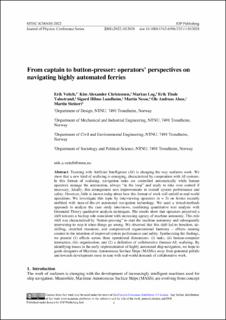| dc.contributor.author | Veitch, Erik Aleksander | |
| dc.contributor.author | Christensen, Kim Alexander | |
| dc.contributor.author | Log, Markus Metallinos | |
| dc.contributor.author | Valestrand, Erik Thule | |
| dc.contributor.author | Lundheim, Sigurd Hilmo | |
| dc.contributor.author | Nesse, Martin | |
| dc.contributor.author | Alsos, Ole Andreas | |
| dc.contributor.author | Steinert, Martin | |
| dc.date.accessioned | 2023-01-09T10:29:12Z | |
| dc.date.available | 2023-01-09T10:29:12Z | |
| dc.date.created | 2022-08-15T11:58:35Z | |
| dc.date.issued | 2022 | |
| dc.identifier.issn | 1742-6588 | |
| dc.identifier.uri | https://hdl.handle.net/11250/3041898 | |
| dc.description.abstract | Teaming with Artificial Intelligence (AI) is changing the way seafarers work. We show that a new kind of seafaring is emerging, characterized by cooperation with AI systems. In this format of seafaring, navigation tasks are controlled automatically while human operators manage the automation, always "in the loop" and ready to take over control if necessary. Ideally, this arrangement sees improvements in overall system performance and safety. However, little is known today about how this format of work will unfold in real-world operations. We investigate this topic by interviewing operators (n = 5) on ferries recently outfitted with state-of-the-art automated navigation technology. We used a mixed-methods approach to analyze the case study interviews, combining quantitative text analysis with Grounded Theory qualitative analysis techniques. The results show that operators perceived a shift towards a backup role coincident with increasing agency of machine autonomy. This role shift was characterized by "button-pressing" to start the machine autonomy and subsequently intervening to stop it when things go wrong. We observed that this shift led to boredom, deskilling, stretched resources, and compromised organizational harmony – effects running counter to the intention of improved system performance and safety. Synthesizing the findings, we present (1) effects across three operational dimensions: (i) tasks, (ii) human-computer interaction, (iii) organization; and (2) a definition of collaborative (human-AI) seafaring. By identifying issues in the early implementation of highly automated ship navigation, we hope to guide designers of Maritime Autonomous Surface Ships (MASSs) away from potential pitfalls and towards development more in tune with real-world demands of collaborative work. | en_US |
| dc.language.iso | eng | en_US |
| dc.publisher | IOP | en_US |
| dc.rights | Navngivelse 4.0 Internasjonal | * |
| dc.rights.uri | http://creativecommons.org/licenses/by/4.0/deed.no | * |
| dc.title | From captain to button-presser: operators’ perspectives on navigating highly automated ferries | en_US |
| dc.title.alternative | From captain to button-presser: operators’ perspectives on navigating highly automated ferries | en_US |
| dc.type | Journal article | en_US |
| dc.type | Peer reviewed | en_US |
| dc.description.version | publishedVersion | en_US |
| dc.source.volume | 2311 | en_US |
| dc.source.journal | Journal of Physics: Conference Series (JPCS) | en_US |
| dc.identifier.doi | 10.1088/1742-6596/2311/1/012028 | |
| dc.identifier.cristin | 2042981 | |
| cristin.ispublished | true | |
| cristin.fulltext | original | |
| cristin.qualitycode | 1 | |

